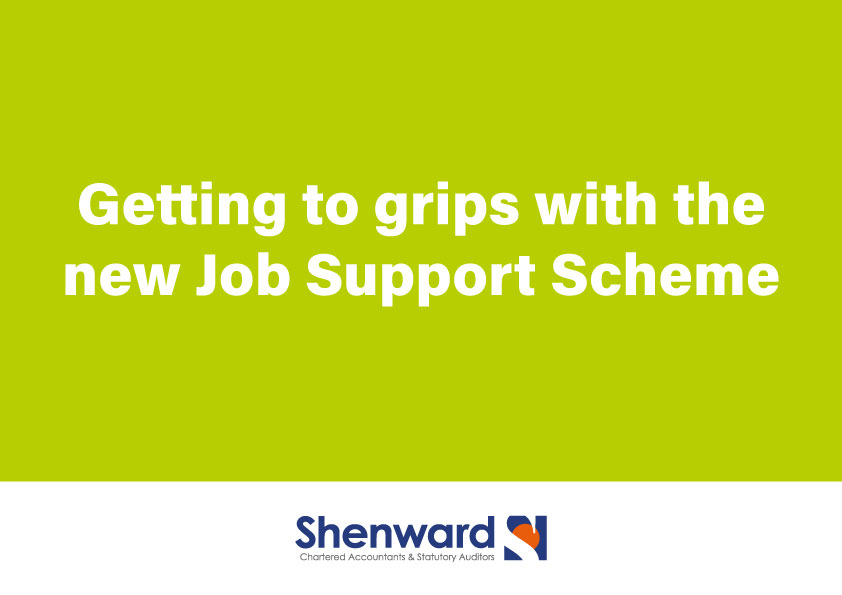Getting to grips with the new Job Support Scheme
It comes as no surprise that as of the 31 October 2020, the Job Retention Scheme that has kept so many businesses afloat throughout the pandemic will come to an end.
However, the good news is that Rishi Sunak announced a new support scheme will come into effect, leaving many business owners feeling relieved. The difficulty is, with so much information floating around, it can be difficult to get to grips with what it means for you and your business.
Here, we break it down so that you’re fully in the loop with how the new Job Support Scheme works.
What is the Job Support Scheme?
The Job Support Scheme has been designed to support those businesses who expect to face lower demand during the winter period as a result of Covid-19. It aims to protect viable jobs and allow business owners to keep their employees attached to the workforce. To put it simply, it is a joint effort from the government, the employee and the employer to ensure that a job remains, and a salary continues to be paid. The government expects this will reduce the amount of redundancies and the number of people facing hardships throughout winter.
How does it work?
A company must continue to pay an employee for the time they have worked at a minimum of a third of their usual hours, with the government providing wage support for some of the remaining hours not worked, and the employee accepting a wage reduction for the rest of the hours.
Eligibility
Whilst the criteria of the Job Support Scheme are slightly less restrictive than the Job Retention Scheme, there are certain criteria in which must be met.
- Any employee employed as of Wednesday 23rd September is eligible.
- All small and medium-sized businesses are eligible, but larger businesses must show their turnover has fallen during the crisis. Employers can use it even if they have not previous used the furlough scheme it replaces
- Employees are protected from redundancy whilst on the scheme.
- There will be restrictions on capital distributions (dividends) to shareholders who are in receipt of the scheme – for large companies.
Example
If an employee earns a salary of £2,000 per month and works 70% of their hours, they will earn £1,400 normal pay plus £200 extra from their employer and £200 from the government being £1,800 in total.
How to make a claim
The scheme will be open from 1 November 2020 to the end of April 2021. Employers will be able to make a claim online through Gov.uk from December 2020 and will be paid on a monthly basis.
Grants will be payable in arrears meaning that a claim can only be submitted in respect of a given pay period, after payment to the employee has been made and that payment has been reported to HMRC via an RTI return.
HMRC will be checking the information and claims and will have the right to withhold claims that are deemed to be fraudulent.
What other support has been made available?
In addition to the Job Support Scheme, the government has announced a series of changes to existing support packages with a view to further helping businesses and business owners survive the next six months.
Self-Employment Income Support Scheme
- Self-employed grant will be extended to 30 April 2021 covering 20% of average monthly trading profits
Bounce back Loans
- Greater flexibility for repayment, currently borrowed over 6 years.
- Pay as You Grow Scheme announced – Loans can now be extended from six to ten years
- You can also move to interest-only or suspend payments for up to 6 months
Coronavirus Business Interruption Loans
- Extended from 30 September to 30 November 2020.
- Facility term extended to 10 years
VAT Deferral
- VAT payments between 20 March and 30 June 2020 deferred to 31 March 2021 can be paid over 11 monthly instalments, interest free.
Self-Assessment Income Tax
- Income tax due by 31 January 2021 can be paid over 12 monthly instalments, interest free.
VAT for Tourism & Hospitality
- 5% VAT rate extended to 31 March 2021, originally due to end on 13 January 2021.
Our reactions
Like always, we welcome any additional support given to businesses throughout this time and agree with the rationale put forward by the Chancellor regarding viable jobs and furlough not being sustainable. However, we do not believe that the Jobs Support Scheme goes far enough to prevent significant unemployment. The fact that businesses have to pay for hours not worked means that there is very little incentive for employers to use it.
The arithmetic of the scheme means that it would cost a firm £1,500 to employ one full-time worker on £17,000, but more than £2,000 a month to employ two half-time workers on the same full-time equivalent salary. For many, this won’t be achievable.
The JSS is intended to limit the reduction of household income compared with say losing their employment completely and moving to Universal Credit but the scheme is much less generous for businesses which gives them little or no incentive to use it. Those employees who work in closed businesses e.g. nightclubs, soft play centres may lose out if they are not working at all.
On a positive note, we welcome the measures set out for the self-employed, bounce back and CBILs, however once again, there’s a whole market of directors who are not paid via PAYE who are not eligible for support. This is of course saddening and worrying.
With regards to the VAT & Income tax deferral, it is vital to remember that this is not a tax saving or reduction. It still needs to be paid albeit at a later date. Therefore, the cash flow will certainly benefit but if businesses and individuals take this to the full advantage, there will come a time when tax liabilities from 2020 will need to be paid along with the future tax liabilities e.g. 2021.
Our advice is to carefully plan ahead where possible do start to pay instalments to smooth cashflow.


